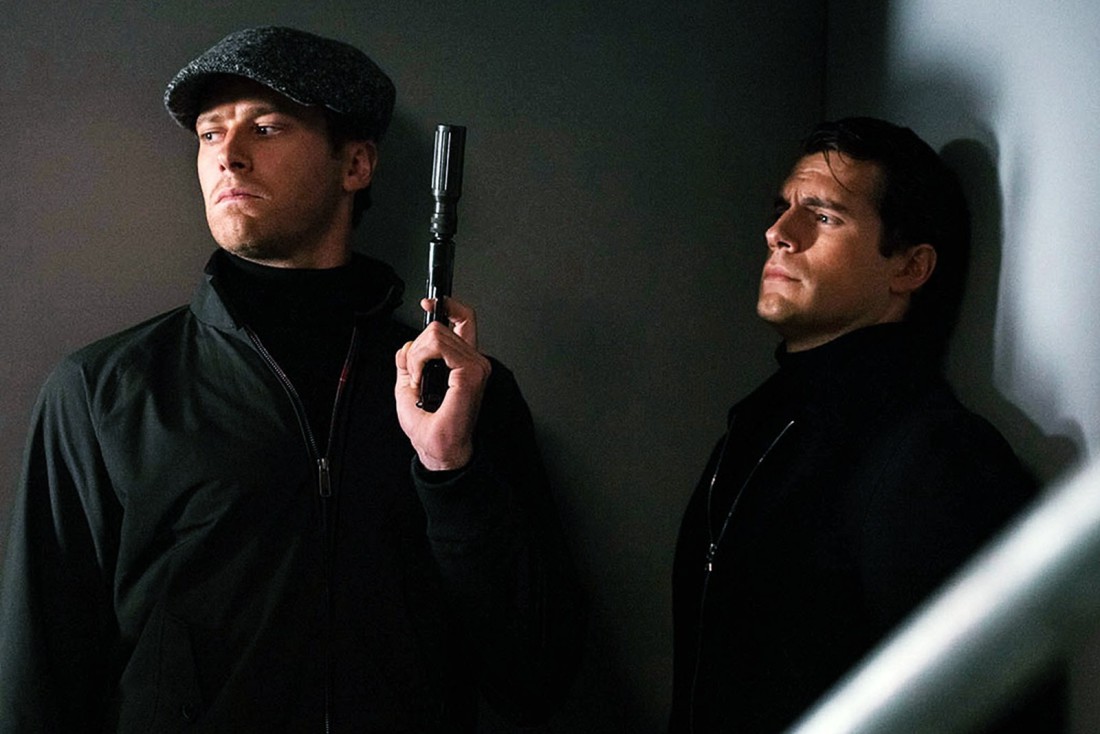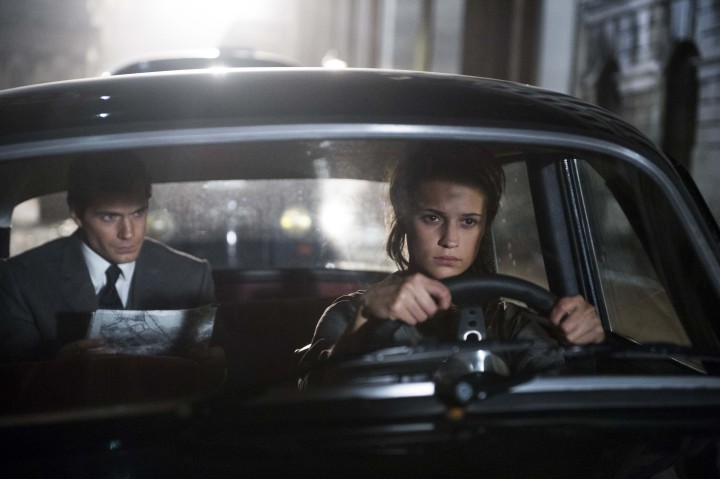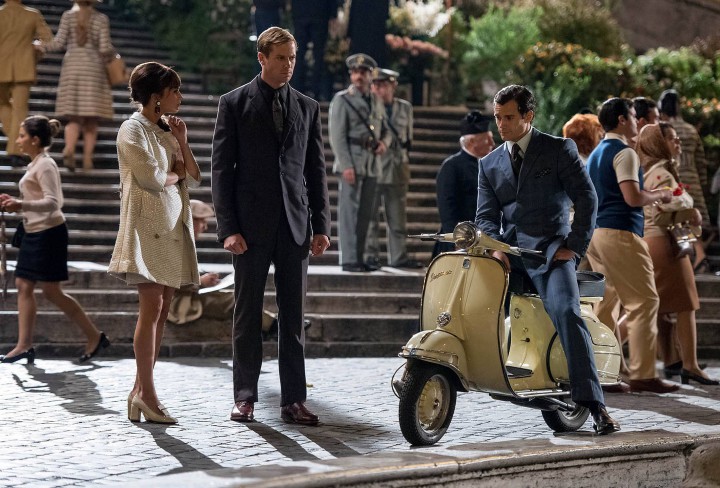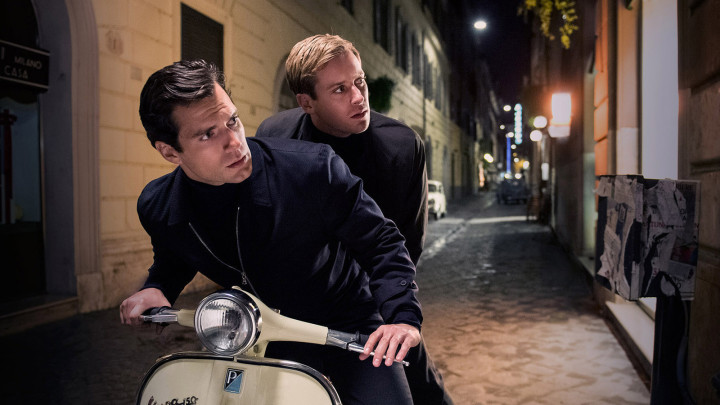Before getting down to the pluses and minuses of Guy Ritchie’s The Man from U.N.C.L.E., I find myself wondering about the fairly common complaint (even in its good reviews) that the film lacks “substance.” Excuse me, but we are talking about The Man from U.N.C.L.E., aren’t we? Now, I don’t remember all that much about the TV series — other than a show with popsicles that functioned as hand grenades when the stick was pulled out, and another episode that involved Napoleon Solo imperiled by a pit-and-the-pendulum device — but I do not recall it ever being accused of substance. Have we become so inundated with self-serious comic book movies and increasingly gloomy James Bond pictures purporting to be somehow important, that there’s no room for a stylish 1960s-style spy picture with no pretense to anything but entertainment? What, for that matter, would a Man from U.N.C.L.E. of “substance” be? And why would we want it?
What Ritchie and co-writer Lionel Wigram (Sherlock Holmes) give us is really less a version of the TV series than a ’60s spy movie that lays the groundwork for that series — an origins story, if you insist. But it differs greatly from most origin stories in that there are no winks at what this will become, unless you count the lead-in to a sequel, at the film’s end. The film merely channels an era — both in time and in film — and an overall style of filmmaking. It exists before the TV series and refers to it not at all. Even the most easily identifiable markers — like the best-remembered theme music and the scenes being connected by swish-pans — are absent from the film. Whether or not this was wise from a box office standpoint, it is certainly a valid choice from an artistic standpoint. That the movie opened to tepid box office may suggest it wasn’t such a hot idea, but the question arises as to whether or not there was that much of market for a big screen version of the 50-year-old TV show to begin with. How (to use a term I detest) relevant is that show today?
The Man from U.N.C.L.E. finds Henry Cavill as Napoleon Solo — here presented as a master thief who has been blackmailed into working for the C.I.A. to avoid prison — and Armie Hammer as Russian agent Illya Kuryakin. At the beginning, they are on opposite sides. Solo is charged with getting Gaby Teller (Alicia Vikander) — whose father is being forced to create a portable atom bomb by some left-over Nazis — out of East Berlin. Kuryakin is supposed to prevent that, leading to the film’s first major action scene. And it’s a scene that establishes Guy Ritchie as the right man to make this film. It is, in fact, the best action scene I’ve encountered all year. It’s clever, stylish, coherent, amusing and exciting. It is sufficiently over the top to capture the flavor of the 1960s spy picture without becoming too ridiculous. That said, Ritchie fans (and I am one) may be a little disappointed by the fact that Ritchie has restrained some of his trademark “Ritchieness,” but it’s what the film needed.
All this is merely set-up, of course, to the antagonistic teaming of Solo and Kuryakin. Again, this takes advantage of being pre-series and allows the movie to present our heroes in greater depth (sort of) than the show allowed. Yes, there’s the decided homoerotic undercurrent of the bickering married couple and one-upsmanship variety, but what do you expect in a film where Solo’s nasty boss (Jared Harris) introduces him to the idea of the partnership with Kuryakin (in a public lavatory, no less) by telling him, “What I’m going to feed you might be bitter, but you’ll just have to swallow it”? Naturally, this leads to a knockdown, drag-out fight between Solo and Kuryakin before they form an uneasy alliance. (It might be noted that Kuryakin ends up in a similar brawl with Gaby by way of a “romantic” encounter a little later.)
What follows is appropriately preposterous with its sexy, elegantly evil villainess (Elizabeth Debicki) and its parade of clever set-pieces. It isn’t as wild a ride as this year’s Kingsman: The Secret Service (which actually referenced the TV show), but it may just be more intelligent. (That may not be in its favor at the box office.) This is a film where two of the funniest and most outrageous scenes — including the death of a torture-crazed Nazi, whose penchant for old-fashioned equipment is his undoing — play out in the background. This may not be subtle exactly, but its brilliant use of the language of film is refreshing. That pretty neatly sums up the whole movie. Rated PG-13 for action violence, some suggestive content, and partial nudity.










Sure looks like a lot of fun. The perfect choice for $5 Wednesdays. Poor Armie Hammer, cant catch a break. All his attempts at blockbusters tank. Too bad, hes good. He had a strong performance in J Edgar even when acting through bad make up.
It is, in fact, the best action scene I’ve encountered all year.
I’ll stand by “bat fight!” from What We Do in the Shadows…and the final battle in Jurassic World…and most things in Mad Max: Fury Road.
I won’t, but those are really very different kinds of action scenes.
Indeed.
I’m not sure if it quite tops the Freebird sequence from KINGSMAN, but it comes damn close.
It seems that often, when two male characters navigate intimacy of some kind, you call it ‘homoerotic’. I haven’t seen this film yet, but it’s something I’ve heard you say at least a handful of times.
You’ll probably see it again next time I think it’s applicable.
Fair enough. Any examples of male intimacy in films that don’t strike you as homoerotic? (This isn’t a challenge, I’m just curious what you’ll say).
Johnny Depp and Armie Hammer in The Lone Ranger comes immediately to mind.
Sometimes a cigar is just a cigar…
And sometimes it’s not.
Loved your review per usual. The first film review I read of yours was for the Lone Ranger, It’s amazing to read a reference to that film in the comment section. Like the Lone Ranger, I was a little disappointed by the mixed reviews and pedestrian box office for UNCLE. It reminded me of the public’s response to The Lone Ranger(I know TLR was an atom bomb of a film). The relationship between the two leads in each film was also similar. These two films, especially TLR are also reminiscent of Richard Lester’s, The Three Musketeers in it’s quirkyness and busyness. A lot going on in every scene.So once again I agree with your review and comment. Thank you.
Thank you!